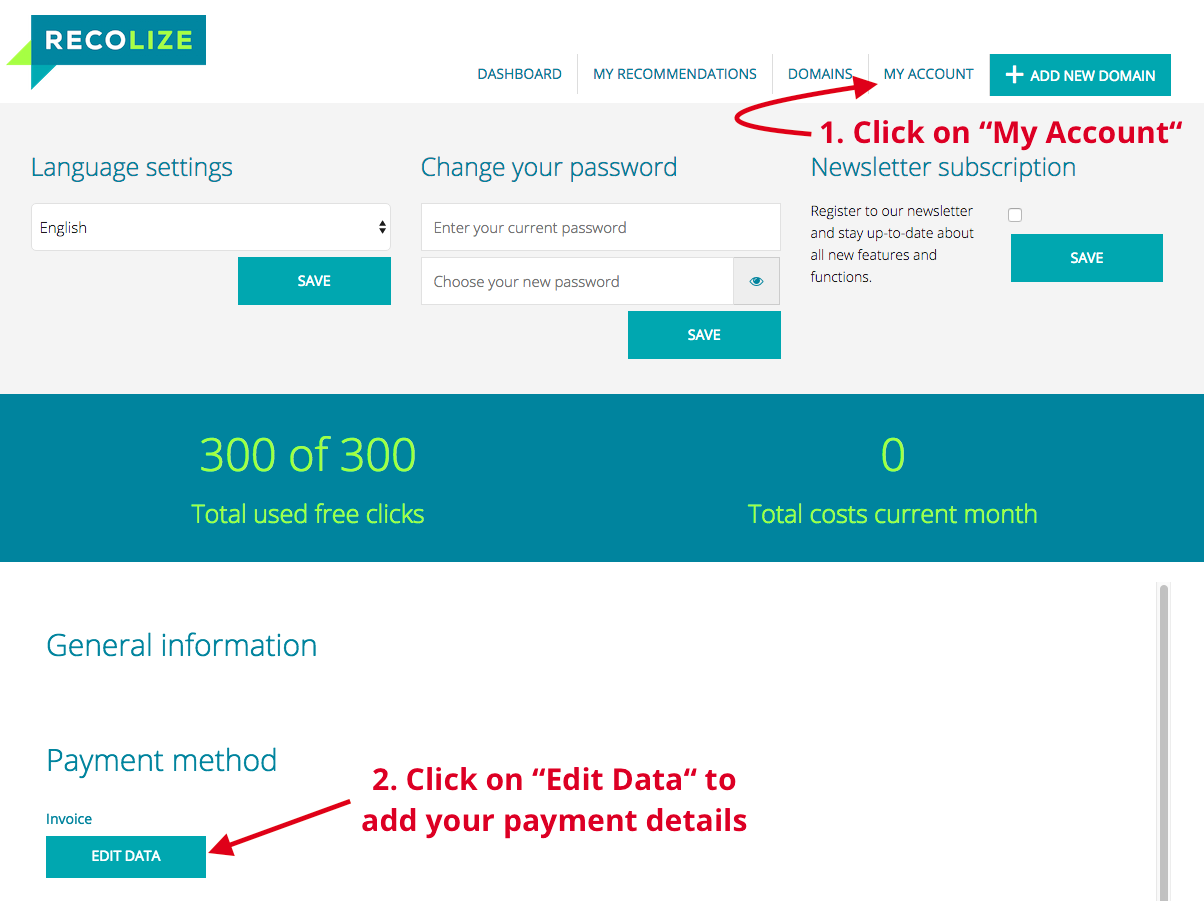Configuration
All answers regarding the configuration of your recommendations
You’ve created a specific filter configuration but the users still get recommended other products? If this is your problem then the personal recommendations of the current user don’t fit to your filter configuration.
If your filter configuration is very restrictive and no matching recommendations are contained in the user’s profile (e.g. the user is only interested in pants but your recommendation is configured to show only products with the category shoes) then the product recommendations of the next matching recommendation are offered. If none of the configured recommendations match for a user then the recommendations are generated by the Recolize Brain.
Choose the filter in the tool according to the description in the right column. Then the filter can be added per drag & drop (click with the mouse, drag the element and drop it) to the filter combination box. After these steps your filter was successfully added.
By default Recolize generates personalized product recommendations, i.e. they are automatically calculated to be the best products for the individual visitor. This works right from the start, that means after the installation you do not have to do anything for this to work.
But of course there are several ways you can influence the recommended items to be able to show pre-defined ones:
1. Go to My Recommendations > Add New Recommendation and configure a new recommendation configuration. Under point “5. Please Choose a Data Pool” you can choose between various options for the data pool:
- Personalized (User-to-User): Automatically calculate the individual recommendations for your visitors based on other visitors. This is the default setting.
- Cross-Sells (Item-to-Item): Automatically calculate the individual recommendations based on the current item.
- Bestseller
- Last Viewed Items
- All Items: This data pool allows static item lists by additionally defining filters. Please select this one.
2. Now you can define the item filters under point “4. Please Define Your Filters”. For example you can limit the static item pool to certain SKUs or items with a price below 10 Euro and something like that.
Please note:
The number of shown articles in our carousel is currently set to 10 because we have made several experiments with our customers and this proved to be the ideal size.
You can exclude items that are out of stock by adding a new Recommendation in the Recolize Tool. Select the “All Pages” URL and add the filter “Is item in stock = Yes”.
You are completely free to position the recommendation widgets wherever you want. Out of the box for most systems like Shopify and Magento we have a default set of positions like e.g. on the product detail page, in cart and on checkout success page.
The position of the recommendation widgets is determined by the configured CSS selectors in our Recolize tool.
Every widget is a new line in the configuration section. You can use all the available css selectors as e.g. documented here.
Example
We assume a configuration as follows:
.main-content .recommendations
.footer
In this case the recommendation widgets will be displayed for every HTML element that matches “.main-content .recommendations” and “.footer”.
Let’s assume that there are 2 positions matching those selectors on your website. Then the first match gets the position 1 and the second one position 2 for the recommendation configuration.
Next to the configuration and styling possibities in our Recolize Tool you can further customize the recommendation widgets via plain CSS.
Therefore all elements in our carousels have explicit CSS selectors that you can use to create your own styling.
These CSS styles can be added in your domain configuration in the Recolize Tool.
Example:
.recolizePrice {
font-size: larger;
}
Recolize supports the following recommendation algorithms:
- User-to-user (“Customers, who bought this, also bought”)
- Item-to-item (“Cross Sells”)
- Top items / Bestseller
- Last viewed
- Static product lists
The algorithms are chosen automatically dependent on the current visited page and the current user to always generate the best matching recommendations.
Recolize uses CSS selectors to control the positions of the Recolize recommendation widgets. The selectors can be configured in the Recolize tool.
A full list of available selectors can be found here. Below we have highlighted some useful ones.
| Selector | Description |
| p:contains(‘Your cart is empty’) | Recommendation Widgets are added right after the text “Your cart is empty”. |
By default we recommend importing the article feed every 12 hours. The value mainly depends on how often your articles change in your system and how fast you want the changes to be reflected in the recommended items. It also depends on how often the product feed is generated on your side.
- Login with your email address under https://tool.recolize.com
- Click on “My Account”
- Click on “Edit Data”
- Add your payment details
We often see confusion regarding the 2 topics “Up-selling” on the one hand and “Cross-selling” on the other hand, although there are major differences between both. In addition, also E-Commerce systems like Magento do not distinguish properly between these two which increase the uncertainty about them.
Generally both terms describe the process of providing recommendations for other products on the basis of one or more products. The difference between Up-selling and Cross-selling will be examined in the following paragraphs.
In the process of Cross-selling several other products are recommended that are similar to the current one and may be exchanged with it. A popular example is a bike tire of brand A that can be exchanged with a tire of brand B that has similar properties (e.g. kind of terrain, pricing, etc.).
In order to be able to display those recommendations Recolize compares and weights the product attributes of the current tire with all available other products and automatically learns and creates those cross-linking connections between them.
For more information about Cross-selling please also see our blog articles about 3 Ways to Integrate Cross-Sells on Product Pages and 15 % Conversion Uplift: Automated vs. Manual Cross-Sells.
On the other hand, Up-selling describes the process of recommending products that are more expensive than the current one(s). Imagine for example you added a watch in the mid-price region to the shopping cart and on the cart page you will be displayed with luxury watches that have a much higher price.
Up-selling in Recolize can be easily done with one click by using its flexible filtering engine.
More use cases for Up-selling can also be found in our blog articles 5 Advantages of Recommendations in Transactional Emails and The Power of Real Individual Recommendations.



